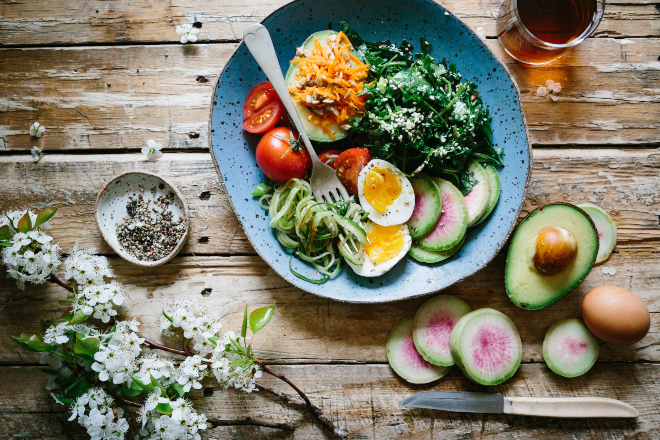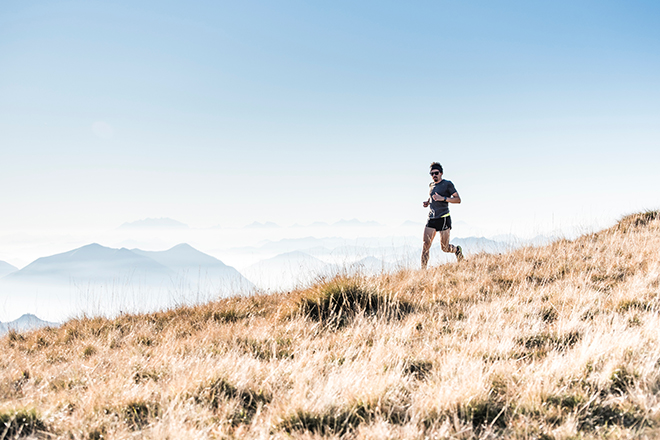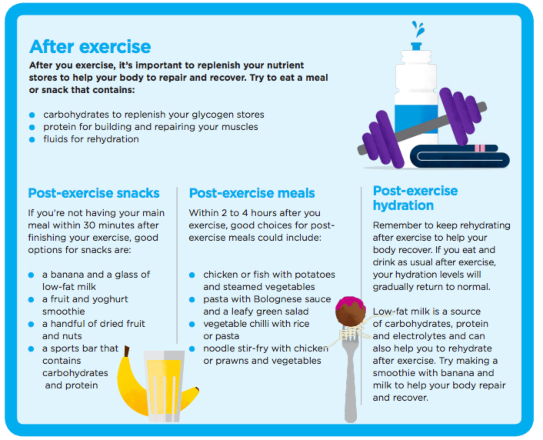The weather is cooling down and the coming months are packed with treks, races, marathons, and all sorts of exercise activities. Knowing what to eat to properly fuel up and how to prep for the big event can be tricky. Health adviser and sports enthusiast Adam Keenan shares his own experience of fuelling throughout training and on race day itself. Here’s everything you need to know about what to eat to prep for a half-marathon.
[pro_ad_display_adzone id="73367"]
1. Maintaining weight
Keenan was training for a half-marathon at time of print, which is classified as an endurance event. Like most other sports, it requires a certain level of aerobic fitness, but a keen sportsperson who takes part in various sporting events will require different training and nutritional strategies depending on what’s next on their calendar. Running burns lots of calories, but losing weight isn’t Keenan’s goal, so he consumes enough calories to maintain a healthy weight. This is particularly important to keep up resistance (or weight) training alongside the half-marathon training.
How many calories do you need to eat? That varies from one person to another and depends on factors such as age, gender, and activity levels. As a rough guide, women need around 2,000 calories each day and men need 2,500. As you start running and training more, you’ll burn more calories and will ultimately need to increase intake. The best tip is simply to be guided by your body: if you’re hungry or lacking in energy, eat!
That said, don’t just fill up on any old rubbish; remember to eat a healthy, balanced diet consisting of carbohydrates, protein, and fats. A healthy diet should provide all the nutrients your body needs to perform and recover well. Carbohydrates are the main source of fuel for exercising muscles. They break down into a type of sugar known as glucose, which provides immediate energy to your body. They’re also stored in your muscles as glycogen. Your muscles can call on these stores when your energy levels are low, so it’s important to keep these topped up with reserves in good supply, especially for an endurance event.

2. What to eat before your activity
Before an exercise, Keenan usually eats a meal or a quick snack that is rich in carbohydrates. With snacks, he tends to opt for a banana or—if having a quick break at work—a cup of Greek yoghurt with fruit and some granola. Both will add simple carbohydrates that can be easily digested.
If he knows he will be doing a longer run straight after work, Keenan says a good tip is to have lunch a little later and make it heavy in carbs. This will give you enough energy and time to digest the food. A good choice for lunch could be a pre-made spaghetti Bolognese from the night before. If you haven’t prepped any food, a jacket potato with tuna and salad (with plenty of beetroots) from your local café will work just as well. But you don’t want to feel uncomfortably full when working out, so as a rule of thumb, try to eat meals around 60 to 90 minutes before exercising.
It’s important to understand that these are not rules set in stone, and you should stay open to adapting your pre-exercise intake to your own workouts. For example, Keenan usually runs 10 kilometres in under an hour, and the above pre-workout sustenance suits his level of activity. But if he ups the intensity of his exercise, like aiming for a quicker time or increasing the distance in training, he will need to rethink his strategy. This usually involves upping the amount of carbohydrate-rich foods (like complex carbs such as brown pasta, rice, or potatoes) that he eats before a run.
Exactly how much carbs you should consume can get technical, with sources saying 10 to 12 grams per kilogram of bodyweight if you’re ‘loading up’ for a workout or a run lasting longer than 90 minutes. For Keenan, that equates to 1,080 grams of carbohydrates per day, which is a lot of food. If you’re not running regularly, you won’t need to carb-load as much. A couple of times per week, Keenan will have an extra portion of carbohydrates—say, two extra bagels at breakfast, an extra portion of rice, or a couple of extra potatoes at dinner. Again, this works well for him, but you should listen to your body and amend your strategy accordingly.
With any pre-workout snack or meal, try to keep the fat and fibre content low as these foods can be harder to digest. They may even cause tummy problems in certain people—not at all ideal, especially before a big race! Keenan also finds that certain types of pasta will make him bloated, lethargic and just generally not in the mood for a run, so he avoids these where possible.

3. What to eat during your activity
If you notice that you’re flagging during runs, think about refuelling along the way. For shorter, more intense runs (around 45 to 75 minutes) you could consume small amounts of a carbohydrate-rich sports drink. Keenan also points out that he may do an oral mouth rinse. This involves swilling with a glucose-based drink and spitting it back out during the run. It’s thought that carbohydrates in the mouth can stimulate the brain and nervous system, and so enhance performance, just as if you drank it. One of the benefits of spitting out the drink is that you don’t consume extra calories. On race day you may also prefer this method, especially if the race provider has a different sponsored drink to the ones you’ve been using in training. Remember that it’s best not to try anything new on race day—play it safe!
For longer runs (up to approximately two and a half hours), refuel with a sports drink or gel. For every hour that Keenan runs he aims to get about 30 to 60 grams of carbohydrates. For reference, a standard 500ml bottle of popular branded sports drink contains around 30 grams. Gels fit nicely in your pockets; a convenient option to run with. On race day, you may find the event organiser offering both, so you may not have to carry either.
There are so many types of gels to choose from, containing different amounts and types of carbohydrates. You can get glucose-only gels or others that contain a mix of glucose and fructose. Read the packaging information to find out what your choice contains, and find a mix that works well for you. Some gels can upset your stomach, which is the last thing you want on a long run, and others can have a funny consistency. Experiment with gels throughout your exercise and don’t leave it to chance on race day.

Photo courtesy of BUPA UK. Click image to enlarge
4. Refuelling and recovery
After an exercise or a big race, you will need to refuel and help your body recover. It can be hard to eat a heavy meal straight after a run, so opt for a liquid-based snack. A glass of milk (skimmed or semi-skimmed) is a good post-exercise option. It contains plenty of vitamins, minerals, protein, and carbs to help restore energy levels and help muscles recover. It’ll also help with rehydration—really an all-round win! Keenan also emphasises prepping and eating a post-workout meal. One of his favourites is a chicken and chorizo pasta meal, which provides a good combination of carbs, protein, and fats. This will also help you reach your five-a-day. See above for some post-workout meal ideas.
We’ve looked extensively at how Adam Keenan eats to fuel his exercise, but the tricky thing with nutrition is that everyone is different. Make sure you eat enough quality foods and stay hydrated—the rest is simply trial and error! Keenan’s parting advice is to go out for a run, taking a banana with you one day and a gel the next, and record what you did differently on each day. Note down how you feel and how well you performed. Even include things like your mood prior to the run and the weather on the day. Recording all these things can help you to build a picture of what you need to perform well.
Finally, have fun and enjoy the exercise—above all, it should make you feel great!
[su_note note_color="#eeeeee"] bupaglobal.com | 2531 8586 | [email protected] [/su_note]
bupaglobal.com | 2531 8586 | [email protected] [/su_note]
DISCLAIMER: This article was designed and produced by Bupa Global by searching internal and external data and information for information provision and reference purposes only. Any views or information mentioned and set out in this article/webpage is based on general situations. Readers should not regard them as medical advice or medical recommendations. Before making any decisions about the theme of this article, you are recommended to seek independent advice from suitable professionals (such as doctors, nutritionists, etc.). It is clearly stated that Bupa Global will not bear any responsibilities for others’ usage or interpretation of the information listed in this article. When preparing and/or updating this article, Bupa Global endeavours to ensure that the content is accurate, complete and updated but will not bear any responsibilities nor make any warranty or guarantee for the accuracy, completeness and timeliness of the information or for any claims and/or losses caused thereby.
[button color=“#008bd2” size=“medium” link=“https://localiiz.us4.list-manage.com/subscribe/post?u=c2964a434922598f5d8ee53ff&id=07d327a2e8” icon=“” target=“true”]Subscribe to receive our weekly newsletter[/button]



 bupaglobal.com | 2531 8586 | [email protected] [/su_note]
bupaglobal.com | 2531 8586 | [email protected] [/su_note]